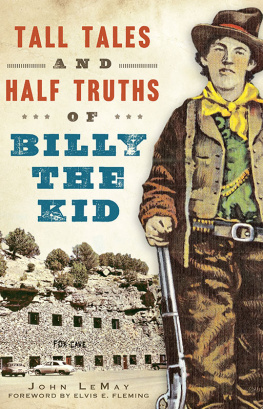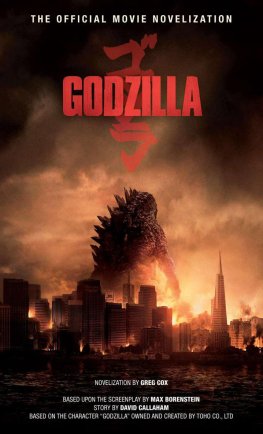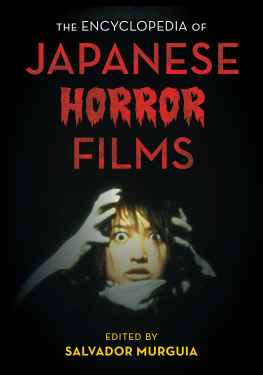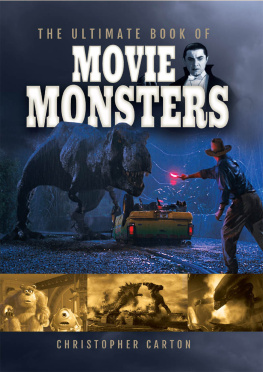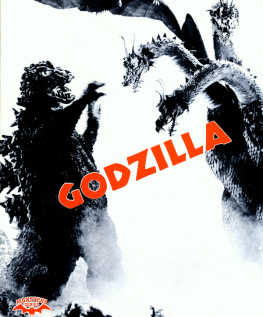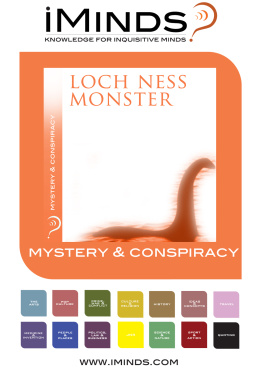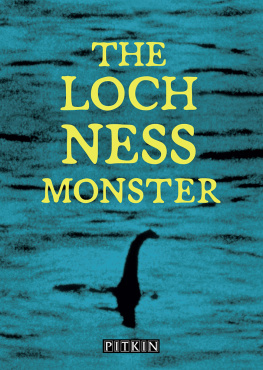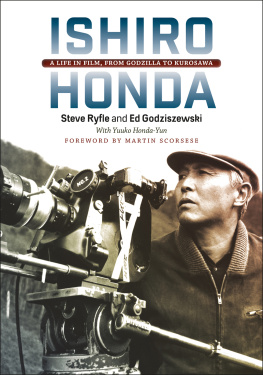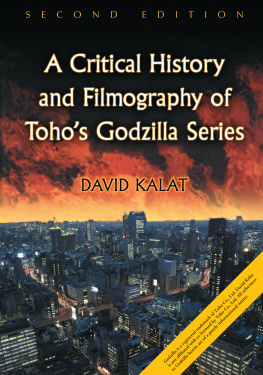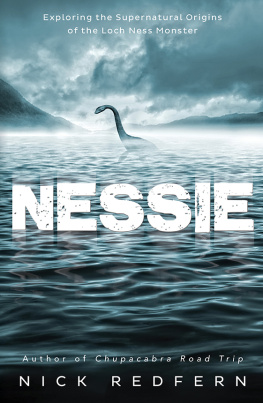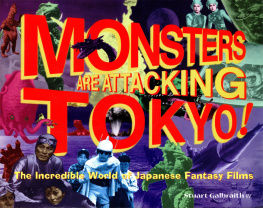THE BIG BOOK OF JAPANESE GIANT MONSTER MOVIES:
THE LOST FILMS
John LeMay
F OREWORD BY J.D. Lees
With Essays by Dr. Ayame Chiba , Stan Hyde,
Mark Jaramillo & Ted Johnson
Edited by Ted Johnson
BICEP BOOKS
2017 by John LeMay. All rights reserved.
The following is a critical analysis and textbook. It has not been approved, authorized, endorsed, licensed, sponsored or associated by any entity involved in creating or producing any Godzilla film. The opinions expressed in this book are those of the authors and do not reflect the views or opinions of Toho International Co., Ltd. or any of its employees.
Toho International Co, Ltd. is the owner of all copyrights and trademarks in its related and respective films, characters and photographs. All of its rights are expressively reserved 1943-2018 Toho Co., Ltd. and its related entities.
Kadokawa Daiei Studio Co., Ltd. is the owner of all copyrights and trademarks in its related and respective films, characters and photographs. All of its rights are expressively reserved.
Toei Studio Co., Ltd. is the owner of all copyrights and trademarks in its related and respective films, characters and photographs. All of its rights are expressively reserved.
Godzilla is a Registered Trademark of Toho Co., Ltd. in Japan as are Anguirus, Rodan, Mothra, Varan, King Ghidorah, Ebirah, Kumonga, Kamacuras, Minilla, Gabara, Gorosaurus, Manda, Baragon, Hedorah, Gigan, Megalon, Jet Jaguar, Mechagodzilla, King Seesar, Titanosaurus, Biollante, Battra, Space Godzilla, Destroyah, Godzilla Junior, Orga, Megaguirus, and Monster X.
Gamera is a Registered Trademark of Kadokawa Daiei Studio Co., Ltd. in Japan.
Ultraman is a Registered Trademark of Tsuburaya Productions Co., Ltd. in Japan.
All text 2017 by John LeMay, All Rights Reserved.
Cover Art by Jared Olive/Delta FX 2017
No part of this book may be reproduced or transmitted in any form or by any means, electronic or mechanical, including photocopying or recording, without written permission from the publisher.
For Neil Riebe, one of the greatest writers
of unproduced dai-kaiju eiga ever
Contents
Acknowledgements
I can honestly say this is the most fun Ive ever had writing a book, and this is in large part due to the dream team of contributors that I got to work with along the way. First off, an especially big thank you to G-Fan features editor Ted Johnson who offered not only to provide an essay, but edit the whole book as well. I first discovered Ted when he began adding in very interesting nuggets of knowledge into my G-Fan articles, and many of the interesting factoids in this tome come from Ted, as do a few entries in Appendix I & II. As most of the information in this book comes from Japanese books that I translated, keep in mind that any misinterpretations of the facts are on the author, and not on the editor. Thank you Dr. Ayame Chiba for looking over my entries on the Gamera films in addition to your wonderful essay. Thank you Don Glut for taking the time to answer questions regarding your script for Ultraman: Hero from the Stars . Mark Jaramillo worked especially hard to put together Appendix IV: Independent Features & Fan Films, so thanks Mark, not only for your efforts as to this title, but tokusatsu independent/fan films as a whole. Thank you super-fan Stan Hyde for your scholarly essay that highlights unmade western giant monster movies (you were the first to agree to do a guest essay and the rest soon followed. Coincidence? I doubt it.) A big thank you to J.D. Lees for taking the time out of his busy G-Fan schedule to write this books foreword. And thanks to the following for answering odd questions here and there, David McRobie, August Ragone, Mike Bogue and pretty much everyone on Facebook Monsterlandnotably Kevin Derendorf, Nick Driscoll and Patrick Galavan to name a few. Thank you, Noe Torres (my co-author on The Real Cowboys and Aliens ) for your help with some technical matters. And also, thanks to the team at Cult Action for digging up hard to find classics and making them available to fans like myself.
Foreword by J.D. Lees
There was a time, not so long ago, when the Internet did not exist. A time when only rich people could afford to screen movies privately in their homes. A time before virtually all known information was as close as the nearest keyboard. And a time when the word kaiju had not yet come into use in the English language.
For many of todays fans of Godzilla and other kaiju, that might sound like a modern version of the Dark Ages, but actually, quite the opposite was true. Those recently bygone days were exciting and intriguing times for genre film fans. The only way to see a movie was to watch the newspaper ads for a first run theatrical screening or scan the TV listings in hopes one of the older films would be scheduled for telecast. A third option was to keep an eye on that popular form of Saturday babysitting, the Kiddy Matinee at a local theater where old monster movies often rose from the cinematic graveyard.
There were also sporadic, and often inaccurate, report of kaiju eiga in monster magazines, and very rarely, books. Thus, it was possible to read about a film and be aware of a film, a film that you desperately wanted to see, but to be unable to actually see it for years! Or to watch a movie in a theater and to love it but have no opportunity to re-watch it again, literally for years.
For fans of kaiju eiga, this exquisite torment was even more acute. The movies we did manage to see were altered forms of an original version. We knew the original existed, but it was inaccessible. There were tantalizing scenes we could never see, such as watching our hero Godzilla triumph over his rival in King Kong vs Godzilla . (Reports of this alternate ending, apparently originating in the pages of Famous Monsters of Filmland magazine, described something that never actually existed. The erroneous belief persisted for years because nobody in the west ever had access to the Japanese version of the movie. Though the Japanese version is very different from the U.S. one, the monster battle ends exactly the same way).
Until the 1990s, most of the available, accurate information about kaiju eiga was incomprehensible to Western fans because it was written in a languageJapanesethat almost none of them could understand. Even in Japan there wasnt much because before then, merchandise and marketing relating to kaiju was relatively limited compared to today.
Evidently, the situation for pre-90s G-fans was very different from what we know today, but it wasnt all bad. Waiting for a classic like Monster Zero to show up on TV built anticipation and when it happened, it was a cause for great celebration. In the meantime, fans learned to defer their gratification, and to trade snippets of information and speculation. One of the positive spin-offs was a sense of community with shared excitement for a common goal.
Today, most of that aspect of kaiju fandom is irretrievably lost. Every Godzilla movie, if not every kaiju movie, is available on DVD or Blu-ray, a streaming service, or online. Look and ye shall find. Not only the American versions are available but the Japanese as well. Those Japanese versions have been subtitled, some licensed, others on the black market. (Even now, however, the subtitles are not always accurate translations, and dont even get me started on dubtitles.)
There are currently more kaiju-related websites in existence than probably anyone knows about. Plot descriptions and commentaries, from brief and sassy to in-depth and reverent, abound. Behind-the-scenes videos and photos are available widespread. Fans trek to iconic locations and studios in Japan and Japanese actors, directors, and technicians make the opposite journey to attend conventions in America, supplying the fans with autographs and information.


